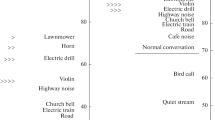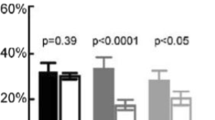Summary
The present investigation was designed to examine the most appropriate duration of instantaneous loudness and to find out the relationship between overall loudness and instantaneous loudness using 20-min road traffic noise. Instantaneous loudness was judged using the method of continuous judgment by category. The results suggest that instantaneous loudness is determined by the sound energy averaged during the 2.5-s period preceding each judgment, the duration of which seems to reflect the psychological present. It was also found that overall loudess is not an average of the instantaneous loudness of every moment, but that it is based on the instantaneous loudness above a certain level.
Similar content being viewed by others
References
Békésy, G. von. (1967). Sensory Inhibition. Princeton: Princeton University Press. (Japanese translation by Y. Katsuki).
Fraisse, P. (1957). Psychologie du Temps. Paris: Press University. (Japanese translation by Y. Hara, revised by K. Sato).
ISO 1996. (1982). Acoustics — Description and measurement of environmental noise — Part 1: Basic quantities and procedures.
Iwahara, S. (1964). Non-parametric Methods. Tokyo: Nihon-Bunka-Kagaku-sha.
Kuwano, S., Namba, S., & Kato, T. (1978) The loudness of impulsive sound. Journal of the Acoustical Society of Japan, 34, 316–317 (in Japanese).
Nakamura, T. (1982). A new method of level-fluctuating noise: specification of the rating period. Japanese Journal of Psychology, 53, 221–227 (in Japanese with English summary).
Nakamura, T., Namba, S., & Kuwano, S. (1978). On the method of incessant categorical judgments. Japanese Journal of Psychology, 49, 152–158 (in Japanese with English summary).
Namba, S., & Kuwano, S. (1980). The relation between overall noisiness and instantaneous judgment of noise and the effect of background noise level on noisiness: Journal of the Acoustical Society of Japan (E), 1, 99–106.
Namba, S., & Kuwano, S. (1982). Psychological study on Leq as a measure of loudness of various kinds of noises. Journal of the Acoustical Society of Japan, 38, 774–785 (in Japanese with English summary).
Namba, S., Kuwano, S., & Kato, T. (1974). The relation between loudness and rise time as a function of energy. Journal of the Acoustical Society of Japan, 30, 144–150 (in Japanese with English summary).
Namba, S., Kuwano, S., & Kato, T. (1976). The loudness of sound with intensity increment. Japanese Psychological Research, 18, 63–72.
Namba, S., Kuwano, S., & Kato, T., (1978a) An investigation of Leq and Lα in relation to loudness. Journal of the Acoustical Society of Japan, 34, 301–307 (in Japanese with English summary).
Namba, S., Kuwano, S., & Nakamura, T. (1978b). Rating of road traffic noise using the method of continuous judgment by category. Journal of the Acoustical Society of Japan, 34, 29–34 (in Japanese with English summary).
Namba, S., Kuwano, S., & Nikaido, S. (1982). Estimation of tone quality of broadcasting sounds using the method of continuous judgment by category. Journal of the Acoustical Society of Japan, 38, 199–210 (in Japanese with English summary).
Namba, S., Nakamura, T., & Kuwano, S. (1977). An analysis of piano performance. Studies in the Humanities and Social Sciences. College of General Education, Osaka University, 25, 25–43 (in Japanese with English summary).
Namba, S., Nakamura, T., & Yasuda, S. (1972). The relation between the loudness and the mean of energy of level-fluctuating noises. Japanese Journal of Psychology, 43, 251–260. (in Japanese with English summary).
Pöppel, E. (1978). Time perception. In R. Held, H.W. Leibowitz, & H.-L. Teuber (Eds.), Handbook of Sensory Physiology: Vol. III. Perception (pp. 713–729). Berlin, Heidelberg. New York: Springer.
Rice, C.G. (1977). Investigation of the trade-off effects of aircraft noise and number. Journal of Sound and Vibration, 52, 325–344.
Woodrow, H. (1951). Time perception. In S.S. Stevens (Ed.), Handbook of Experimental Psychology (pp. 1124–1236). New York: John Wiley & Sons.
Author information
Authors and Affiliations
Rights and permissions
About this article
Cite this article
Kuwano, S., Namba, S. Continuous judgment of level-fluctuating sounds and the relationship between overall loudness and instantaneous loudness. Psychol. Res 47, 27–37 (1985). https://doi.org/10.1007/BF00309216
Received:
Issue Date:
DOI: https://doi.org/10.1007/BF00309216




